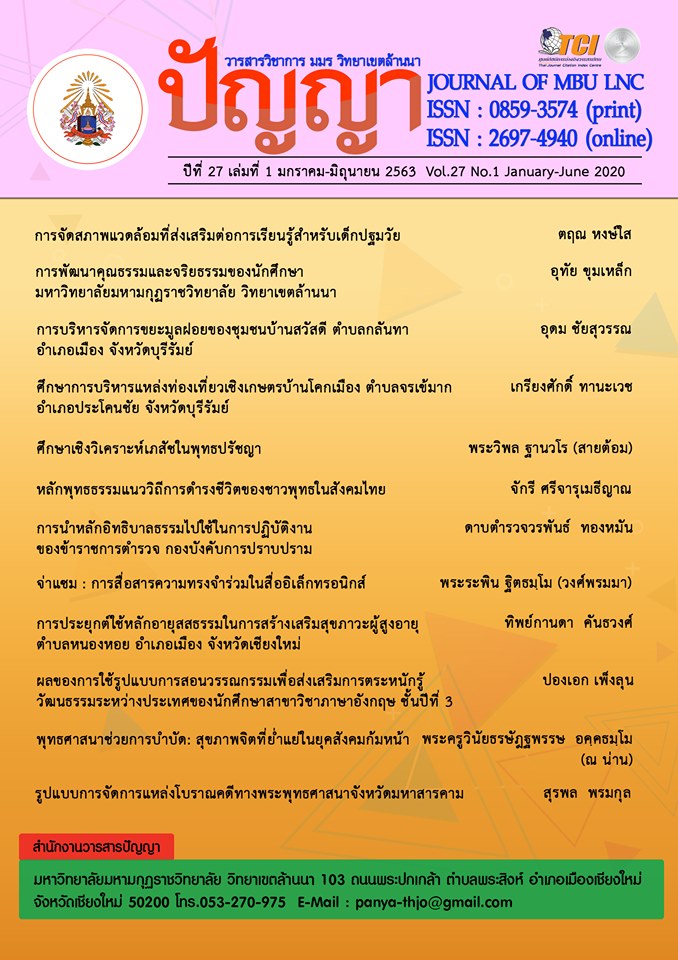The รูปแบบการสอนวรรณกรรมในการส่งเสริมการตระหนักรู้วัฒนธรรมระหว่างประเทศของนักศึกษาสาขาวิชาภาษาอังกฤษ ชั้นปีที่ 3 คณะครุศาสตร์ มหาวิทยาลัยราชภัฏบุรีรัมย์
คำสำคัญ:
รูปแบบการสอนวรรณกรรม, การตระหนักรู้วัฒนธรรมระหว่างประเทศ, นักศึกษาสาขาวิชาภาษาอังกฤษชั้นปีที่ 3บทคัดย่อ
บทความวิจัยนี้มีวัตถุประสงค์คือ 1) เพื่อศึกษาการใช้รูปแบบการสอนวรรณกรรมในการส่งเสริมการตระหนักรู้วัฒนธรรมระหว่างประเทศของนักศึกษา และ 2) เพื่อศึกษาทัศนคติของนักศึกษาต่อการใช้รูปแบบการสอนวรรณกรรม กลุ่มตัวอย่างคือ นักศึกษาสาขาวิชาภาษาอังกฤษ ชั้นปีที่ 3 คณะครุศาสตร์ มหาวิทยาลัยราชภัฏบุรีรัมย์ จำนวน 24 คน ปีการศึกษา 2562 ซึ่งได้มาโดยการเลือกแบบสุ่มอย่างง่าย (Simple Random Sampling) งานวิจัยนี้ได้เก็บข้อมูลวิจัยเชิงปริมาณและเชิงคุณภาพในการทดลอง 9 สัปดาห์ เครื่องมือที่ใช้ในการศึกษาครั้งนี้คือ 1) บทเรียนเรื่องสั้น 9 แผน 2) แบบทดสอบการตระหนักรู้วัฒนธรรมระหว่างประเทศ
3) แบบสอบถาม และแบบสอบถามปลายเปิด 4) แบบสังเกตในชั้นเรียน ข้อมูลเชิงปริมาณใช้การวิเคราะห์ทางสถิติโดยการหาค่า paired sample t-test ค่าเฉลี่ย ค่าเบี่ยงเบนมาตรฐาน และข้อมูลเชิงคุณภาพใช้การวิเคราะห์เนื้อหา
ผลการศึกษาพบว่า 1) มีความแตกต่างระหว่างคะแนนเฉลี่ยจากแบบทดสอบการตระหนักรู้วัฒนธรรมก่อนและหลังเรียนอย่างมีนัยสำคัญทางสถิติที่ระดับ .05 มีค่าอิทธิพลเฉลี่ยระดับมาก (1.35) และการตระหนักรู้ของนักศึกษาอยู่ในระดับ การตระหนักรู้วัฒนธรรมระหว่างประเทศ 2) นักศึกษามีทัศนคติในแง่บวกต่อการสอนโดยใช้รูปแบบการสอนวรรณกรรม นอกจากนี้ ผลการศึกษาของแบบสังเกตในชั้นเรียนพบว่า นักศึกษาได้เปลี่ยนแปลงทัศนคติ และยอมรับความเหมือนและความแตกต่างทางวัฒนธรรมหลังการใช้รูปแบบการสอนวรรณกรรม
เอกสารอ้างอิง
ASEAN. (2009). Association of Southeast Asian Nations. Retrieved 9 July, 2019, from https://asean.org/asean/about-Asean/.
Baker, W. (2009). Intercultural awareness and intercultural communication through English: An investigation of Thai English users in high education. (Doctoral dissertation, University of Southampton).
Baker, W. (2012). From cultural awareness to intercultural awareness: culture in ELT.ELT Journal, 66(1), 62-70.
Chlopek, Z. (2008). The Intercultural approach to EFL teaching and learning. English teaching. Forum, 46(4), 10-19. Retrieved 10 December, 2019, from https://eric.ed.gov/?id=EJ1096289.
Choeichaiyapoom, P. (2013). Effect of English instruction using intercultural approach on intercultural awareness of upper secondary school students. (Master’s thesis, Chulalongkorn University).
Cohen, J. (1988). Statistical power analysis for the behavioral sciences (2nd ed.). New Jersey: Erlbaum.
Cronbach, L. J. (1974). Essential of Psychological Testing. New York: Harper & Row.
Bachelor of Education. (2017). English Curriculum, Buriram: Buriram Rajabhat University.
Furr, M. (2004). Literature circle for EFL classroom, Proceedings of the 2003 TESOL Arabia Conference. Arabia: Dubai.
Irawati, D. (2017). Effectiveness of Literature Circles on Students’ Reading Comprehension. IJOLTL: Indonesian Journal of Language Teaching and Linguistics, 1(3), 179.
Jauss, H. (1981). Toward an aesthetic of reception. Minneapolis: University of Minnesota Press.
Kaowiwattanakul, S. (2012). Preparing EFL Classroom for Asian Economic Community (AEC): Using Literature Circle to Promote Students’ English Language Skills, Critical Thinking Skills and Cultural Awareness, International Conference on Cultural and Linguistic Diversity in ASEAN. Bangkok: Suan Dusit Rajabhat University.
Kaowiwattanakul, S. (2019). Fostering EFL Students’ Global Mindedness at the Undergraduate Level through the Use of Literature Teaching Activity Based on a Reader-Response theory. PASAA PARITAT JOURNAL, 34, 136-153.
Karatay, H. (2017). The Effect of Literature Circles on Text Analysis and Reading Desire. Retrieved 19 December, 2019 from https://files.eric.ed.gov/ fulltext/EJ1155611.pdf.
Keshavarzi, A. (2012). Use of Literature in Teaching English. Procedia - Social and Behavioral Sciences, 46, 554- 559. Retrieved 9 October, 2019from https://www.researchgate.net/publication/271582388_Use_of_Literature_in_Teaching_English.
Leask, B. (2009). Using Formal and Informal Curricula to improve interactions between home and international students. Journal of studies in International Education, 13, 205-221. Retrieved 8 September, 2019, from https://journals.sagepub.com/doi/pdf/10.1177/1028315308329792.
Liao, M. Hs. (2019). Cultivating Critical Thinking through Literature Circles in EFL Context. Spectrum: Studies in Language, Literature, Translation, and Interpretation, 17(5), 89-116
Liu, C. (2016). Cultivation of Intercultural Awareness in EFL Teaching, Journal of Language Teaching and Research, 7(1), 226-232.
Masavisut, N. & Boccuzzi, E. (2008). The S.E.A Write Anthology of ASEAN Short Stories and Poems: The 30th Anniversary. New Jersey: Silkroad Agency.
Paran, A. (2008). The role of literature in instructed foreign language learning and teaching: An evidence-based survey. Language Teaching, 41(4), 465-496. Retrieved 18 September, 2019 from https://www.researchgate.net/ publication/231992110_The_Role_of_Literature_in_Instructed_Foreign_Language_Learning_and_Teaching_An_Evidence-Based_Survey
Rosenblatt, L. M. (1978). The reader, the text, and the poem: The transactional theory of the literary work. Carbondale, Illinois: Southern Illinois University Press.
The Office of Council of Rajabhat University President. (2011). A Study on the Preparation of Rajabhat University for Participation in the Building of ASEAN Community in 2011. Bangkok: The Office of Council of Rajabhat University Presidents of Thailand.
Varita, D. (2017). Improving Reading Comprehension through Literature Circles, English Education Journal (EEJ), pp.234-244.



